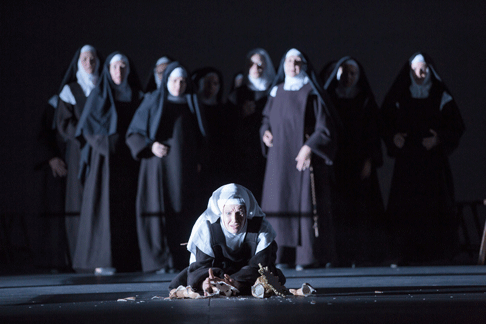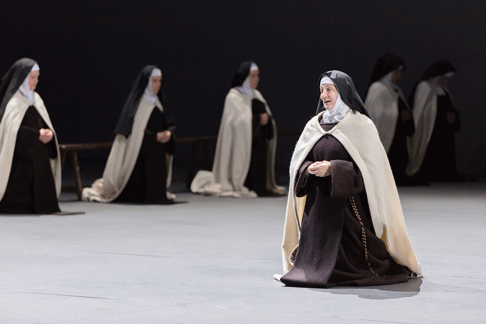02 Jun 2014
Dialogues des Carmélites, Royal Opera
A black bare stage heaving with a rebellious revolutionary throng; they stare with still hostility directly at the audience, stark light streaming from above.

A black bare stage heaving with a rebellious revolutionary throng; they stare with still hostility directly at the audience, stark light streaming from above.
A scene from Boublil’s and Schönberg’s Les Misérables? No. The opening moments of Robert Carsen’s much-acclaimed production of Poulenc’s opera of courage, cruelty and redemption.
In need of some insurgent sans culottes, Carsen has (in partnership with an unlikely alliance of Streetwise Opera, Synergy Theatre Project, the Department for Work and Pensions, and the Royal Central School of Speech and Drama) supplemented his already large cast with a 67-strong ‘Community Ensemble’. Comprising those who ‘have experienced homelessness, the criminal justice system and long-term unemployment, as well as those studying drama and theatre in learning and community settings’, this massed crowd convincingly represents an oppressed, insurrectionary populace. Meticulously choreographed by Movement Director Philippe Giraudeau, they form a silent congregation of collective dissatisfaction and unrest — a palpable incarnation of menace and terror.
Dialogues des Carmélites presents a ‘true story’, recorded by a Carmelite nun, Sister Marie of the Incarnation, who survived the French Revolution. Her account of persecution and piety was subsequently presented in various forms by the German novelist, Gertrud von Le Fort and the playwright Georges Bernanos, and also adapted in a scenario by Philippe Agostini and the Rev. Bruckberger — the complex lineage being further knotted by the fact that writer Emmet Lavery had purchased the exclusive rights to Bernanos’ drama, causing Poulenc considerable difficulty when he sought to adapt his own libretto from Bernanos’ play.
 Sally Matthews as Blanche
Sally Matthews as Blanche
Despite the nonchalant indifference of her father, the Marquis de la Force, the young Blanche de la Force fears the mounting anarchic fervour in Revolutionary Paris; convincing the Carmelite Prioress of her vocation, she takes refuge in a convent but — despite the reputed protection of the Blessed Virgin — it rapidly becomes apparent that the cloistered walls are no safeguard against radical remonstration. The faith of the devout is tested, and the ultimate sacrifice is demanded.
Carsen’s production, designed for Netherlands Opera in 1997, has been widely seen and greatly admired worldwide in the years since; given that Dialogues des Carmélites has not graced the ROH stage since 1983, and that Sir Simon Rattle was scheduled to lead a fine cast of soloists (several of whom had previously performed roles in the 2008 revival at Theater an der Wien), one can understand the excitement and expectation surrounding the arrival of the production in London at last.
In many ways, it lives up to the hype. The minimalist staging is arresting and Carsen offers some powerful directorial gestures which are complemented by Jean Kalman’s expressionistic lighting; the latter provides many ravishing, and fearsome, moments. The soloist excel. And, Rattle clearly knows and loves this score: the brass play with purity and restraint in the chorale-like passages, and Rattle creates an iridescent sound-world in which glistening harps ripple and luscious strings surge in rapture, coloured by silky woodwind slithers, but one which is also ominously punctuated by shuddering, jagged rhythmic bursts of terror and brutality. The percussive slashes of the final march to the scaffold reveal the full unleashed force of the Royal Opera House Orchestra.
Yet, despite Rattle’s care and attention — and Carsen’s imaginative faithfulness to the composer’s reputed preference for stagings which adopt a monastic austerity — there is no getting away from the fact that the score is dominated by an ever-repeating two-bar progression, in various harmonic inversions and timbral colourings, an infinite chain which becomes increasingly more wearisome and which makes it difficult to establish and sustain any driving musico-dramatic direction. Typical of the nature of Poulenc’s idiom is the terrifyingly moving final scene, which is underpinned by a rocking minor third; it is the raw rip of the slicing guillotine which provides the drama, rather than any harmonic conflict.
 Emma Bell as Madame Lidoine
Emma Bell as Madame Lidoine
One cannot deny that there are moments of musical exhilaration and stunning dramatic frisson — the Father Confessor (Alan Oke) devoutly leading the doomed nuns in a last prayer; Blanche, in fear and hysteria forebodingly dropping the statue of the Infant Christ. When the Revolutionary forces finally confiscate the nuns’ Carmélite habits, there is a gripping encounter between Blanche (Sally Matthews), who has now fled the cloister in dread, and Mother Marie (Sophie Koch), who tries to convince her to return to save her soul. So, there is thus much gripping theatre; but it doesn’t feel like music-drama, and there are some scenes where Poulenc overly draws things out. At times Carsen’s direction emphasises this ‘static’ quality, the crowded tableaux serving like photographs or freeze frames out of which the principals step for momentary, self-contained dramas.
There is, however, still much to relish. Carsen’s production has a stark beauty: the bare stage is adorned with just a chair, some wooden trellises, a white-draped bed. The monochrome simplicity is intermittently lit in chiaroscuro, the gothic silhouettes which loom suddenly upon the black back walls suggesting the terrible menace of the mob beyond. Streaks of light and colour occasionally animate the darkness, communicating mood and meaning. Reserved for the aristocrats, the regal red velvet and heraldic purple silk of the opening scene emphasises the irreconcilable chasm between those within the chateau walls and those on the streets beyond.
Attired pre-Carmélite vows in a sumptuous ivory gown, Sally Matthews visually embodied the ‘Power of innocence’ that her name, Blanche de la Force, implies. And, while she was rather tremulous in the middle range, Matthews produced a bright clarity at the top when Blanche succumbs to her fears. She seemed, however, to lack an innate feeling for Poulenc’s limpid idiom and the soprano’s French diction was poor — although she was certainly not alone among the cast in this regard.
Blanche’s companion and confidante, Sister Constance, was sung with charm and vivacity by Anna Prohaska, capturing all of the independent-minded nun’s eccentricities and vigour. Prohaska brought a beguiling tenderness to the erratic nun’s passionate temperament. As Mother Marie of the Incarnation Sophie Koch was superb, consistently an authoritative musical and theatrical presence; luminous of voice, Koch also has the power to convey the Assistant Prioress’s steely centre and religious intensity, and her absence from the final scene was as moving as the tragic fates which await those who are present.
Emma Bell, as Madame Lidoine, the second Prioress, was also full of voice, and Deborah Polaski offered a deeply committed cameo as the dying Madame de Croissy. This Prioress was certainly not going quietly, raging frantically against death and life — if anything one would have liked even more vocal ugliness to scar the lyrical fervency. Even if one shares the initial reluctance to embrace the spirit of voluntary mass martyrdom felt by Blanche (for personal reasons) and Madame Lidoine (for doctrinal motives), and feels rather removed from the self-abnegations of institutional cloisters and the spirit of Catholic obedience and devotion which might inspire mass martyrdom, this was the visceral stuff of life and death.
Amid the multitude of female voices there were also strong performances by the men, despite the indisposition of Alan Oke — who nevertheless was a dignified Father Confessor — and Yann Beuron, who was replaced as Blanche’s brother, Chevalier de la Force, by Jette Parker Young Artist Luis Gomez in Act 2. Gomez sang with full-throated passion in a striking confrontation between the siblings, as the Chevalier tries to persuade his sister to flee with him to safety. Thomas Allen (Marquis de la Force), Neil Gillespie (the valet Thierry) and John Bernays (the physician Monsieur Javelinot) all made effective, if brief, contributions.
One problem with Poulenc’s libretto is that there is little sense of the nuns as individuals, no information about their lives before they have made their commitment to God: instead, they maintain their ubiquitous — and rather distancing — chant-like serenity to the last. In the shocking final scene, clothed in pure white underdresses, the condemned nuns slowly succumb to guillotine, their outstretched arms an icon of mankind’s ultimate sin and grace. The choric voice gradually diminishes. As the Salve Regina floats heavenwards, we are reminded of Carsen’s opening image: neatly folded habits arrayed decorously across the stage. We now understand that, swathed in silver light, they were a foreshadowing of the redemption and transcendence to come. With this closing intimation of resurrection Carsen offers his final masterstroke.
Claire Seymour
Cast and production information:
Blanche, Sally Matthews; Constance, Anna Prohaska; Madame Lidoine, Emma Bell; Mère Marie, Sophie Koch; Madame de Croissy, Deborah Polaski; Marquis de la Force, Thomas Allen; Chevalier de la Force, Yann Beuron; Mother Jeanne, Elizabeth Sikora; Sister Mathilde, Catherine Carby; Father Confessor, Alan Oke; First Commissary, David Butt Philip; Second Commissary, Michel de Souza; First Officer, Ashley Riches; Gaoler, Craig Smith; M. Javelinot, John Bernays; Thierry, Neil Gillespie.
Director, Robert Carsen; Conductor, Simon Rattle; Set designs, Michael Levine; Costume designs, Falk Bauer; Lighting design, Jean Kalman; Movement, Philippe Giraudeau; Orchestra of the Royal Opera House; Royal Opera Chorus. Royal Opera House, Covent Garden, London, Thursday 29th May 2014.